Doberman Ear Cropping – Is It Necessary Or Cruel?
Whether you have recently adopted a Doberman or are just starting the process of looking for one, you might be interested to know about ear cropping.
Doberman ear cropping is a surgical procedure that is commonly used to alter the appearance of a Doberman’s ears by removing a portion of the ear.
The ears are then wrapped and trained to stand upright over the course of several months.
Ear cropping has a lot of controversy around it, so we are going to break down everything that you need to know about the process before adopting your dog.
At What Age Can You Crop Your Doberman’s Ears
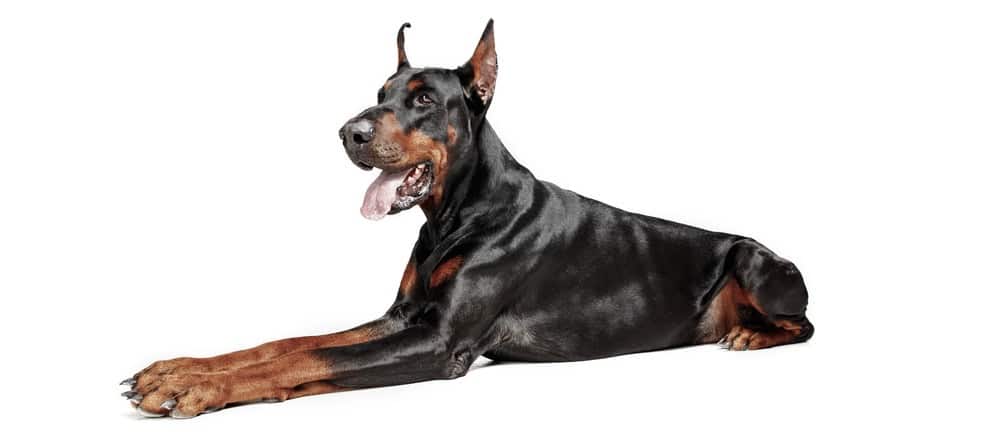
If you are looking to have your Doberman have the more traditional Doberman aesthetic, you might be wondering when that will happen.
Can you cut a Doberman’s ears at any age? You really cannot have your Doberman’s ears cropped at any old time. It has to be done at a set time.
Normally, a Doberman’s ears will be cropped when the dog is between 7 and 9 weeks old. There are some veterinarians who will do it as late as 12 weeks old, but that is not as common.
You certainly do not want to have it done any later than that as the damage will be severe. If your vet is offering to do it at an older age, you need to find a new vet. After 12 weeks old, the Doberman’s ear cartilage will have hardened after that and reshaping the ears to stand up will not be possible.
What Do Doberman’s Ears Look Like
While we are more aware of what a Doberman looks like with his ears cropped, their natural ears look very different. When they are puppies, Doberman ears are floppy and soft.
They fold down, much like Labrador retriever ears do. In fact, it is unlikely that you would recognize a Doberman in his natural form if you saw him out, because we are so accustomed to associating Dobermans with short, pointy ears and short, stubby tails.

Their ears remain floppy and wide as they grow into adulthood. The only way to get them to have ears that stand up is through cosmetic surgery.
The Reasons Why People Crop Doberman’s Ears
As the topic of ear cropping has become more controversial over the years, it is a common question to ask why people crop Doberman ears at all. There are several common reasons that this is done, including:
It’s the Standard
When you think about a Doberman, the first thing that people think of is their pointed ears and body type. Cropped ears have become the traditional look for a Doberman.
Originally, this was done because they are used as guard dogs and shorter ears cannot be grabbed or ripped off in a fight. Some people also like that it makes the look more intimidating and tough.
For Competitions and Shows
The standard look for a Doberman who competes at dog shows is to have cropped ears and a cropped tail.
If showing your purebred Doberman is your goal, then ear cropping would definitely be in your future as this is considered the breed standard by the American Kennel Club (AKC)
Other Reasons
There are also other reasons that are listed as why people crop Doberman ears, including the idea that the dogs can hear better and will be less prone to ear infections. Neither of these justifications are backed up with scientific evidence.
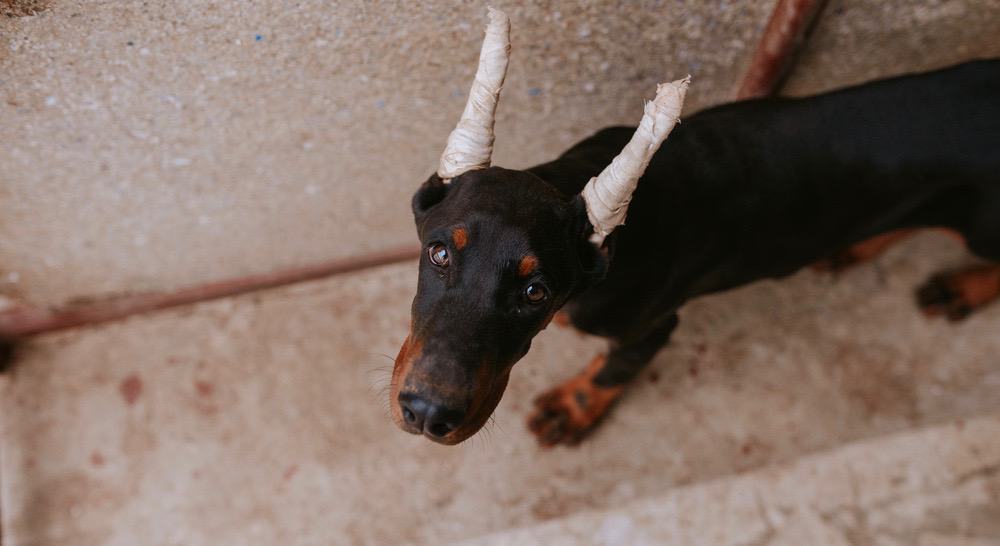
Whether a dog’s ears point upward or droop downward, their hearing is not affected. Dobermans are also not more prone to ear infections than any other breed and cropping would not do anything to prevent them. Generally, the purpose is cosmetic and cultural, not medically necessary.
Is It Cruel To Crop Your Doberman’s Ears?
It is a fierce debate as to whether Dobermans should have their ears cropped. While the AKC states that it is acceptable and the norm for the breed, the American Veterinary Medical Association (AVMA) has spoken against the practice, stating that it is solely for cosmetic purposes and cruel as a result.
There are many risks associated with cropping your Doberman’s ears, including the following:
Trauma: To begin with, the procedure is traumatic. You are removing part of the dog’s anatomy, which is painful.
Increased Risk of Infection: There is also an increased risk of infection as the surgical operation will remove skin and leave your dog with wounds that need to be kept clean and covered until they can heal.
Sensitivity: There is also more sensitivity to touch for dogs that have had their ears altered, because there is less protection for the skin and the cut skin will have more exposed nerves.
Perception of Aggression: Dobermans who have had their ears cut are thought to appear more aggressive and will be treated with more hostility by strangers.
Loss of Communication and Expression: Finally, dogs use their ears to communicate, so when they have been cropped, Dobermans can’t use them that way.
The Ear Cropping Procedure
When a Doberman puppy is between 7 and 9 weeks of age, they can have their ears cropped. The cropping procedure is a surgical procedure that happens under anaesthesia.
The procedure itself will take about 30 minutes to accomplish and the puppy will have his ears taped after surgery. The tape will have to remain in place for 5 to 6 months in order to train the ears to stand upright. Some dogs can take up to a year for their ears to fully stand up.
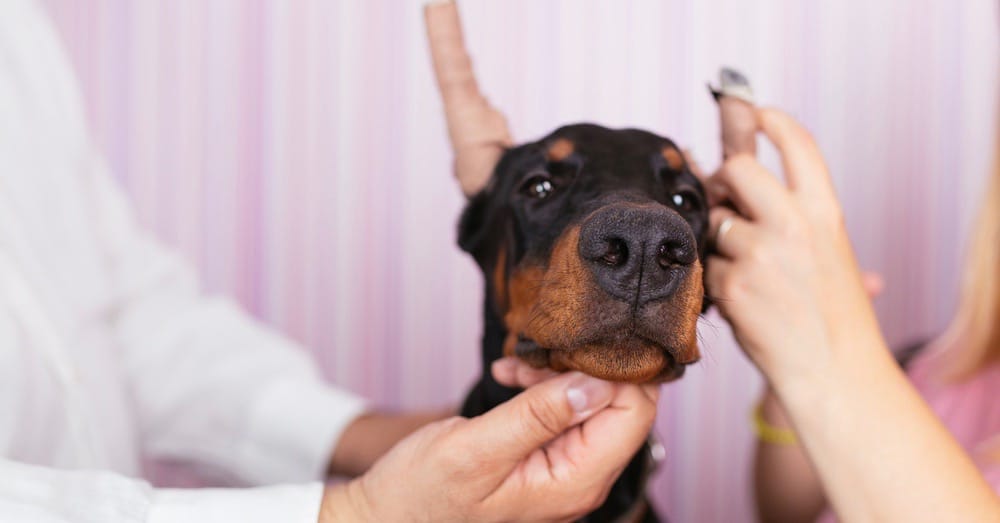
In reality, the taping process and the healing portion of cropping is more uncomfortable that the surgery is itself. There is a greater risk of infection during this period and you will have to make sure that the puppy doesn’t rub the tape off.
The lengthy aftercare requires a lot of attention, so if you are not prepared for that, this might not be the right procedure for you to try out.
Doberman Ear Cropping Styles
There are four primary ways to crop your Doberman’s ears. They are:
Battle Crop: This is the shortest crop type. The ears are cut low to provide protection from the ears being grabbed during a fight.
Working Crop: The working crop, also known as a military crop, is also a short type of crop. This is the most popular type of dropping technique and is often used for show dogs. The ears are short with a wide base, and a triangular shape to the ears.
Medium Crop: This method is longer than the first two. The cut is less severe than with the battle or working crops, but the aftercare is a lot longer if you are hoping to get the dog’s ears to stand up.
Show Crop: This is the longest crop type. The ears wind up a little more curved and it takes longer to train the ears to stand up than any of the other crops.
How To Find A Good Vet That Can Crop Your Doberman’s Ears
As cropping has become less and less popular over the years, it is more difficult than ever to find a vet who will perform this service for you.
Many vets believe that it is an unnecessary cosmetic procedure and will refuse to do it. When you find a vet that will agree to do it, you really need to make sure that your vet knows what he’s doing.
The first place to ask about finding a vet is from the breeder that you got your Doberman from. A Doberman breeder should be up-to-date on where ear cropping can happen.

In some cases, the breeder will have the procedure done for you, so when you initially adopt your puppy, his ears can already be cut and ready to work on the aftercare training.
You will need to call around to your local vets and see who does the procedure. When you find one that agrees, you will need to ask questions to make sure that the vet is qualified to do the procedure, such as how much experience the vet has, what the recommended age for cropping is, and so on.
The other alternative is to not have cropping done at all and skip the trouble.
Can Your Crop Older Doberman’s Ears?
If your Doberman is beyond the 12 week cut off, you might be wondering whether you can still have your Doberman’s ears cropped.
Since the goal of ear cropping is a certain aesthetic, cropping ears past that age will not work out. If you are hoping to have the appearance where the ears are standing up, you will want to keep the cropping within the 7 to 9 week timeframe.
12 weeks being the absolute latest that you can do it. Otherwise, the ears will still lay down and they will not stand up.
Likewise, you cannot crop a Doberman’s ears when he is too young either, or the proportions will likely be off as the Doberman grows.
An experienced vet who is familiar with ear cropping with Dobermans should be able to guide you on when the appropriate time would be, but you should know the earliest is 6 weeks and the latest is 12 weeks.
Ear Cropping & Legal Aspect
As we mentioned above, ear cropping is a controversial topic. In most European Union countries, the practice has been banned completely.
In the United States, Russia, and a few other Eastern European countries Doberman ear cropping is still allowed. In the United Kingdom, ear cropping was banned under the Animal Welfare Act of 2006. The U.S. has not made any kind of regulation regarding the practice, allowing it to continue as it is.
Even though it is legal in the United States, there is not a unified front about the practice itself. The AKC states that it is an allowable procedure, in no way inhumane, and is the standard and expected appearance of a Doberman.
The AKC was surprised when the AVMA came out and announced that they were not in support of the procedure and thought that it would be traumatic for the dog to experience with many risks at play.
Doberman Without Cropped Ears
When you come across a Doberman that has not had his ears or tail docked, you might not even recognize that the dog is a Doberman at first. When their features are left in place, they resemble Labradors in their tail and ears.
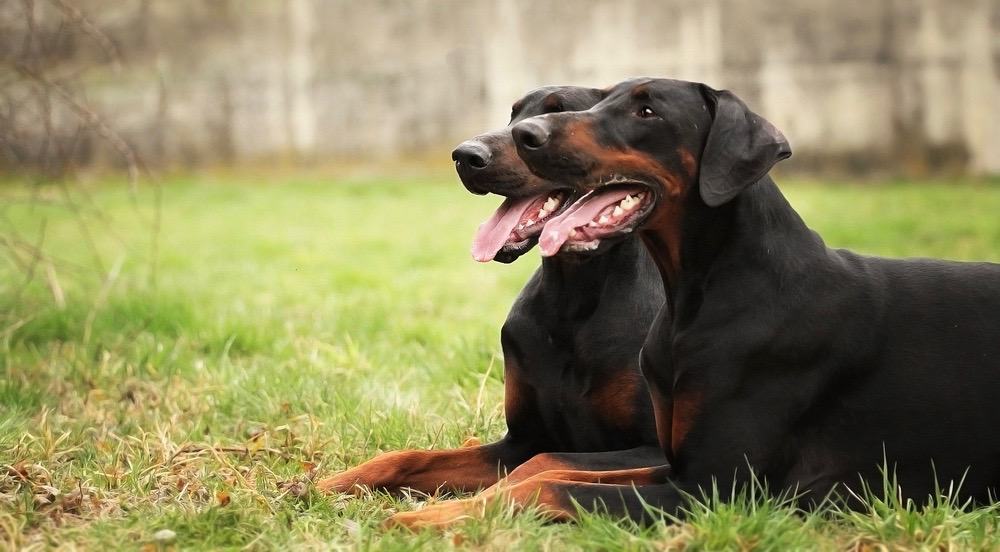
Their body type is still naturally muscular and leaner, but their appearance does change. The way that the dog will be treated by strangers is also different, because people are less likely to be afraid of him without the distinctive pointy ears.
If you adopt an older Doberman who has not been altered, you will not be able to alter the Doberman at that point and will just need to stick with the natural look.
Doberman Ear Cropping Prices & Recovery Time
There is quite a price range for cropping the ears of your Doberman. The general range that you can expect is anywhere from $300 to $1,000, depending on where you are at and the age of the dog when you are having the procedure done. Your vet will be able to give you an accurate price estimate.
The recovery time for the procedure is long and might make you rethink having it done. Once the ears have been cut, they are then wrapped up and stabilized so that as they heal, they will heal into the sharp upright shape that you are going for.
The recovery time is about 5 to 6 months on average, but it can take as long as a year, depending on the type of cut was used. This is why the window of getting the ears cropped is so important. If you try to do it on an older dog, the results will not be what you are after and the trauma will be greater.
Doberman Ear Cleaning & Health
Regardless of whether you decide to have your dog’s ears cropped or not, you will need to make sure that you are keeping your dog’s ears clean.
It would be best to get him acclimated to you touching his ears when he is young so that he lets you continue to clean them as he gets older.
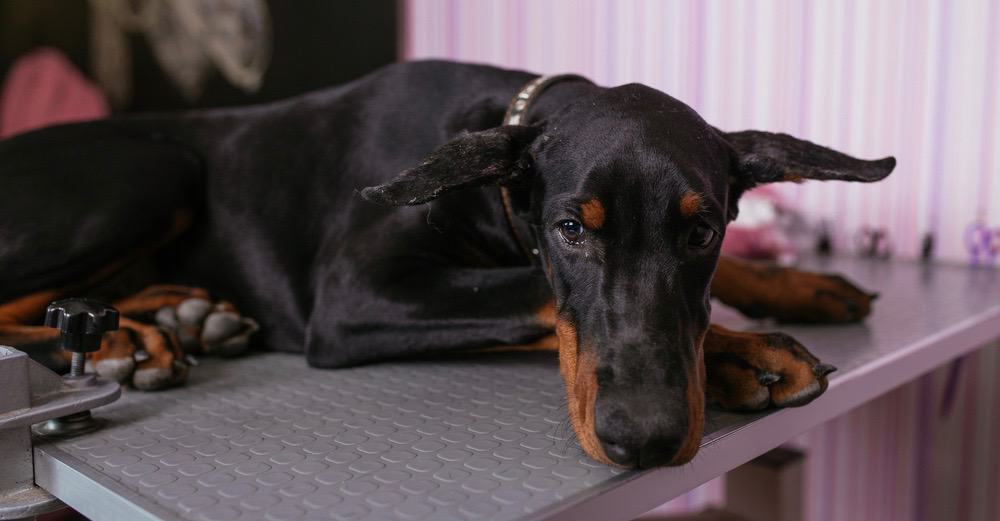
You can clean your dog’s ears with dog ear cleaning solution. You just need to drop one or two drops in each ear and then gently massage the ears. This will help keep bacteria away.
In general, dog ears are made to be self-cleaning, so if you are not seeing any issues with the ears, it might be best to check in with your vet about the recommended cleaning for your dog. Look for any visible wax or debris. You can also check if your dog doesn’t seem to be hearing you well and look for dirty ears.
Final Words
Ultimately, it is up to you whether you decide to have your Doberman’s ears cropped or leave them as they are naturally. The procedure of cropping ears has been found to be only cosmetic, so consider your choices wisely before deciding one way or another.
People will have the dog’s ears cropped if they are going to be in a position where they will likely have to fight, so keeping the ears short will prevent them from getting ripped off in a battle. If you are planning on showing your dog, you might also need to crop the ears.
Remember that you cannot undo a cropping, so make your choice wisely.






